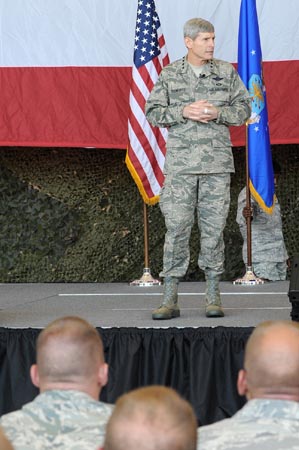Unique Contributions
The  Air Force must sustain its unique contributions to national security in the face of a rapidly changing global security environment, said Gen. Norton Schwartz, Chief of Staff, in the CSAF Vector 2011, the document laying out his goals for the service for the coming year. Those contributions are: establish control in air, space, and cyberspace; hold any target at risk; provide responsive intelligence-surveillance-reconnaissance; rapidly move people and cargo anywhere in the world; and provide command and control to conduct operations rapidly, effectively, and efficiently. To support these areas, the Air Force must maintain "an enduring technological edge," writes Schwartz. He adds: "Our investment in high caliber people and technology must continue to outpace our rivals if we hope to sustain access to the commons, deter armed conflict, and prevail in war." Among the many items highlighted, Schwartz wants the service to revitalize thinking about "crisis stability and 21st century deterrence dynamics," seek "broader, global access to bases," "redouble efforts" in electronic warfare in the face of "fierce competition," and enhance care for wounded airmen. Schwartz issued the document on Monday. (For more on the CSAF Vector, read Schwartz Calls for Renewed Focus on Unit Readiness.)
Air Force must sustain its unique contributions to national security in the face of a rapidly changing global security environment, said Gen. Norton Schwartz, Chief of Staff, in the CSAF Vector 2011, the document laying out his goals for the service for the coming year. Those contributions are: establish control in air, space, and cyberspace; hold any target at risk; provide responsive intelligence-surveillance-reconnaissance; rapidly move people and cargo anywhere in the world; and provide command and control to conduct operations rapidly, effectively, and efficiently. To support these areas, the Air Force must maintain "an enduring technological edge," writes Schwartz. He adds: "Our investment in high caliber people and technology must continue to outpace our rivals if we hope to sustain access to the commons, deter armed conflict, and prevail in war." Among the many items highlighted, Schwartz wants the service to revitalize thinking about "crisis stability and 21st century deterrence dynamics," seek "broader, global access to bases," "redouble efforts" in electronic warfare in the face of "fierce competition," and enhance care for wounded airmen. Schwartz issued the document on Monday. (For more on the CSAF Vector, read Schwartz Calls for Renewed Focus on Unit Readiness.)
 Air Force must sustain its unique contributions to national security in the face of a rapidly changing global security environment, said Gen. Norton Schwartz, Chief of Staff, in the CSAF Vector 2011, the document laying out his goals for the service for the coming year. Those contributions are: establish control in air, space, and cyberspace; hold any target at risk; provide responsive intelligence-surveillance-reconnaissance; rapidly move people and cargo anywhere in the world; and provide command and control to conduct operations rapidly, effectively, and efficiently. To support these areas, the Air Force must maintain "an enduring technological edge," writes Schwartz. He adds: "Our investment in high caliber people and technology must continue to outpace our rivals if we hope to sustain access to the commons, deter armed conflict, and prevail in war." Among the many items highlighted, Schwartz wants the service to revitalize thinking about "crisis stability and 21st century deterrence dynamics," seek "broader, global access to bases," "redouble efforts" in electronic warfare in the face of "fierce competition," and enhance care for wounded airmen. Schwartz issued the document on Monday. (For more on the CSAF Vector, read Schwartz Calls for Renewed Focus on Unit Readiness.)
Air Force must sustain its unique contributions to national security in the face of a rapidly changing global security environment, said Gen. Norton Schwartz, Chief of Staff, in the CSAF Vector 2011, the document laying out his goals for the service for the coming year. Those contributions are: establish control in air, space, and cyberspace; hold any target at risk; provide responsive intelligence-surveillance-reconnaissance; rapidly move people and cargo anywhere in the world; and provide command and control to conduct operations rapidly, effectively, and efficiently. To support these areas, the Air Force must maintain "an enduring technological edge," writes Schwartz. He adds: "Our investment in high caliber people and technology must continue to outpace our rivals if we hope to sustain access to the commons, deter armed conflict, and prevail in war." Among the many items highlighted, Schwartz wants the service to revitalize thinking about "crisis stability and 21st century deterrence dynamics," seek "broader, global access to bases," "redouble efforts" in electronic warfare in the face of "fierce competition," and enhance care for wounded airmen. Schwartz issued the document on Monday. (For more on the CSAF Vector, read Schwartz Calls for Renewed Focus on Unit Readiness.)